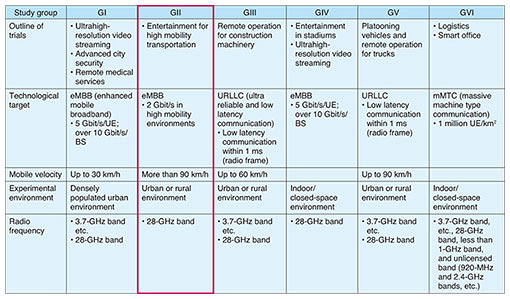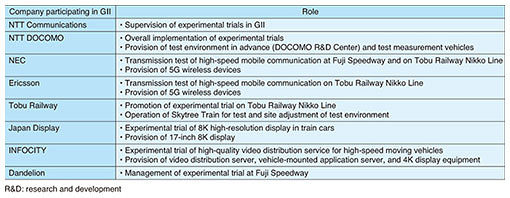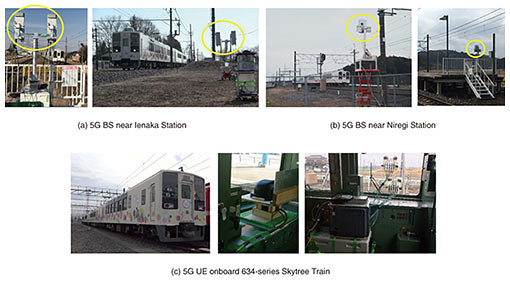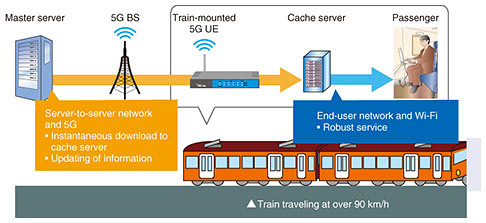 |
|
|
|
|
|
Feature Articles: 5G Field Trials toward Social Implementation Vol. 16, No. 10, pp. 54–59, Oct. 2018. https://doi.org/10.53829/ntr201810fa9 Field Trials of Use Cases in High Mobility Environment toward Social Implementation of 5GAbstractExperimental trials of use cases of fifth-generation mobile communications systems (5G) in high mobility environments exceeding 90 km/h were carried out as part of the 5G Field Trials initiated by the Ministry of Internal Affairs and Communications of Japan. These trials were conducted to evaluate the transmission and distribution of high-presence, high-resolution video and audio content of sightseeing information, news, advertisements, and entertainment content by 5G for passengers in cars traveling on highways and in trains traveling on a conventional line. Keywords: 5G, field trials, high mobility environment 1. IntroductionExperimental trials were conducted as part of a project to examine the technical specifications for fifth-generation mobile communications systems (5G) that can achieve a data communication speed exceeding 2 Gbit/s in high mobility environments (study group GII). The trials were contracted to NTT Communications by the Ministry of Internal Affairs and Communications (MIC) as the main implementing entity and conducted in cooperation with NTT DOCOMO (Table 1). In this article, we describe an overview of the trials and introduce some experiments to transmit entertainment content for vehicle passengers as a potential application area. The roles of the organizations participating in the experimental trials are listed in Table 2.
2. 5G wireless transmission tests in high mobility environment exceeding 90 km/hTwo transmission tests were conducted to evaluate the transmission characteristics of 5G radio access in mobile environments consisting of a bus or private car traveling on a highway and a high-speed train traveling on a railway line. One test was conducted with a car at Fuji Speedway and one was done with a train on the Tobu Railway Nikko Line. 2.1 Transmission test with car at Fuji SpeedwayAt Fuji Speedway (Shizuoka Prefecture) from February 7 to 9, 2018, a 5G communication area was constructed near the grandstand, and an experimental trial—assuming 5G radio transmission to a car moving at high speed—was conducted (Fig. 1).
The base station (BS) was installed near the grandstand of the home straight, set at an azimuth angle of 45° to the track, and the user equipment (UE) was mounted on the roof of the measurement car. The specifications of the transmission equipment consisted of a center frequency of 27.9 GHz, bandwidth of 700 MHz, and 96 (BS) and 64 (UE) antenna elements. A maximum throughput of 2.24 Gbit/s was obtained as the result when the car was traveling at a speed of 90 km/h. 2.2 Transmission test with a train on Tobu Railway Nikko LineFrom February 19 to 23, 2018, in cooperation with Tobu Railway Co., Ltd., 5G communication areas were set up near Ienaka Station and Niregi Station (Tochigi Prefecture) on the Tobu Railway Nikko Line. Experimental trials in those areas were conducted with a 634-series Skytree Train running at high speed under the assumption of 5G wireless transmission for a high-speed railway (Fig. 2).
The BS baseband equipment #1 (subordinate to the core-network equipment) was installed at the northern end of the platform of Ienaka Station, and the BS baseband equipment #2 was installed on vacant land on the south side of the station building. This equipment configuration enabled handover testing across the BS. Two antenna units (for transmission diversity) were connected to BS baseband equipment #1 and #2. The antenna unit of the UE was fixed in the crew cabin of the Skytree Train to ensure line-of-sight (LOS) between the BSs and UE. The major specifications of the transmission equipment included a center frequency of 27.9 GHz, bandwidth of 700 MHz, and 96 (BS) and 64 (UE) antenna elements. The test result indicated that when the train was traveling at a speed of 90 km/h, a maximum throughput of 2.08 Gbit/s was obtained, and handover between BSs was successful. Near Niregi Station, the BS was configured as distributed antennas. The major specifications were as follows: the center frequency was 27.9 GHz, bandwidth was 730.5 MHz, and there were 128×2 units (BS) and 8 (UE) antenna elements. The UE was installed inside the train, and its antenna was attached to the front window of the driver’s seat (via an acrylic panel) to ensure the best-possible LOS. The test result revealed that a maximum throughput of 2.90 Gbit/s was obtained when the train was traveling at a speed of 90 km/h. 3. Experimental trial to transmit entertainment contentWith public transport, the longer the distance traveled, the more time is taken traveling, and high mobility is required. Under those circumstances, it is important for passengers spending time traveling at high speed to have entertainment, and it should be provided with high quality such as having high-resolution images. Therefore, to evaluate a service utilizing 5G during high-speed transit, an experimental trial was conducted of a high-resolution video service for passengers carried by passenger transport operators such as railways, buses, and taxis at speeds of over 90 km/h (Fig. 3).
One of the main forms of usage of 5G services by passengers traveling in trains or passenger cars (traveling vehicles) is expected to be Internet-connected services, and it is assumed that such services will be included as a basic feature. This trial was carried out in order to visualize and evaluate 5G-specific services, specifically, a high-resolution video service providing information and entertainment content for passengers traveling at high speed. For a 5G video delivery service for passengers in vehicles, it is anticipated that information-provision services with higher-resolution video information, more channels, and better timeliness (such as live distribution of video) will be possible thanks to the large capacity of 5G services compared to services using conventional transmission methods. Video distribution services are roughly categorized as either linear-delivery type (programming type) services or on-demand distribution type services. In this experimental trial, only a limited number of BSs could be prepared, so the time to communicate in the high mobility environment was also limited. Consequently, our aim was to obtain the advantages of both the linear-delivery service (timeliness) and the on-demand delivery service (convenience), so a hybrid delivery service was implemented and experimentally verified (Fig. 4).
In cooperation with INFOCITY, INC., a cache server was installed between a video distribution server (master server) installed on the BS side and the UE devices in the train, and the network was separated into two networks: a server-to-server network (from the master server to the cache server) and an end-user network (from the cache server to the UE devices). The server-to-server synchronization function enables the service operator to add content of the master server, and even if the cache server cannot use 5G communication at the time of the updating, the content of the cache server can be appropriately updated at a later time when 5G communication becomes available, and users can be provided with instantaneous services similar to live distribution. From February 19 to 23, 2018, this hybrid-type video delivery system was used to conduct an experimental trial to download multiple 4K and 8K video files simultaneously in the 5G area set up near Tobu Railway’s Ienaka Station (Fig. 5).
During the 21-s period in which the train passes through the 5G area, a 4K and 8K video file with a total size of 1.2 GB was transferred, and video images were displayed on a 4K display and a 17-inch 8K display (provided by Japan Display Inc.) installed in the train. Achieving Gbit/s-grade ultrahigh-speed communication in high mobility environments will make it possible to deliver high-resolution video clips (such as the latest news) to passengers of high-speed rail services in a timely manner. Trademark notesAll brand names, product names, and company names that appear in this article are trademarks or registered trademarks of their respective owners. |
|


















